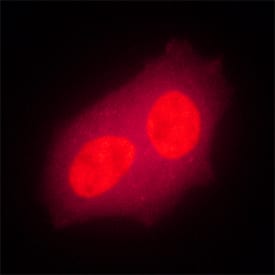Human Bora Antibody
R&D Systems, part of Bio-Techne | Catalog # MAB6856

Key Product Details
Species Reactivity
Human
Applications
Immunocytochemistry
Label
Unconjugated
Antibody Source
Monoclonal Mouse IgG2B Clone # 694730
Product Specifications
Immunogen
E. coli-derived recombinant human Bora
Gly2-Ala180
Accession # Q6PGQ7
Gly2-Ala180
Accession # Q6PGQ7
Specificity
Detects human Bora in direct ELISAs.
Clonality
Monoclonal
Host
Mouse
Isotype
IgG2B
Scientific Data Images for Human Bora Antibody
Bora in MCF‑7 Human Cell Line.
Bora was detected in immersion fixed MCF-7 human breast cancer cell line using Mouse Anti-Human Bora Monoclonal Antibody (Catalog # MAB6856) at 25 µg/mL for 3 hours at room temperature. Cells were stained using the NorthernLights™ 557-conjugated Anti-Mouse IgG Secondary Antibody (red; Catalog # NL007). Specific staining was localized to nuclei. View our protocol for Fluorescent ICC Staining of Cells on Coverslips.Applications for Human Bora Antibody
Application
Recommended Usage
Immunocytochemistry
8-25 µg/mL
Sample: Immersion fixed MCF‑7 human breast cancer cell line
Sample: Immersion fixed MCF‑7 human breast cancer cell line
Formulation, Preparation, and Storage
Purification
Protein A or G purified from hybridoma culture supernatant
Reconstitution
Sterile PBS to a final concentration of 0.5 mg/mL. For liquid material, refer to CoA for concentration.
Formulation
Lyophilized from a 0.2 μm filtered solution in PBS with Trehalose. *Small pack size (SP) is supplied either lyophilized or as a 0.2 µm filtered solution in PBS.
Shipping
Lyophilized product is shipped at ambient temperature. Liquid small pack size (-SP) is shipped with polar packs. Upon receipt, store immediately at the temperature recommended below.
Stability & Storage
Use a manual defrost freezer and avoid repeated freeze-thaw cycles.
- 12 months from date of receipt, -20 to -70 °C as supplied.
- 1 month, 2 to 8 °C under sterile conditions after reconstitution.
- 6 months, -20 to -70 °C under sterile conditions after reconstitution.
Background: Bora
Long Name
Protein Aurora Borealis
Alternate Names
Aurora Borealis, C13orf34
Gene Symbol
BORA
UniProt
Additional Bora Products
Product Documents for Human Bora Antibody
Product Specific Notices for Human Bora Antibody
For research use only
